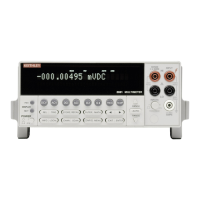IEEE-488 Reference
4-201
The :TYPE command is used to select auto-zero type. When SYNChronous auto-zero is enabled
(see :STATe), the zero signal measurement will occur with every reading conversion. When
NORMal auto-zero is enabled, the zero signal measurement will occur every 200msec.
Normal auto-zero is a compromise between synchronous auto-zero and disabling auto-zero. It
will give you better speed than synchronous auto-zero and update zero at a regular interval.
Programming example 10 OUTPUT 716; “:syst:azer:type sync; type?”
20 ENTER 716; A$
30 PRINT A$
40 END
Line 10 Two commands in this program message; the first selects synchronous auto-zero, and
the second queries the auto-zero type.
Line 20 Addresses the Model 2001 to talk.
Line 30 Displays auto-zero type (SYNC).
:STATe <b>
:SYSTem:AZERo:STATe <b> Control auto-zero
Parameters <b> = 1 or ON Enable auto-zero
= 0 or OFF Disable auto-zero
Format :syst:azer:stat <b>
Defaults Power-up Saved power-on setup
*RST ON
:SYSTem:PRESet ON
Query :STATe? Query state of auto-zero
Short-form format: :syst:azer:stat?
Response message: 1 (on) or 0 (off)
Description This command is used to disable or enable auto-zero.
Important Note: Before you can enable or disable auto-zero, the Model 2001 must first be in
the idle state. The Model 2001 can be placed in the idle state by first disabling continuous initi-
ation (:INITiate:CONTinuous OFF), and then sending the :ABORt command. After sending
the :STATe command, readings can be re-started by sending :INITiate:CONTinuous ON or
:INITiate.
Programming example 10 OUTPUT 716; “:init:cont off; :abor”
20 OUTPUT 716; “:syst:azer:stat off; stat?”
30 ENTER 716; A$
40 PRINT A$
50 OUTPUT 716; “:init:cont:on”
60 END

